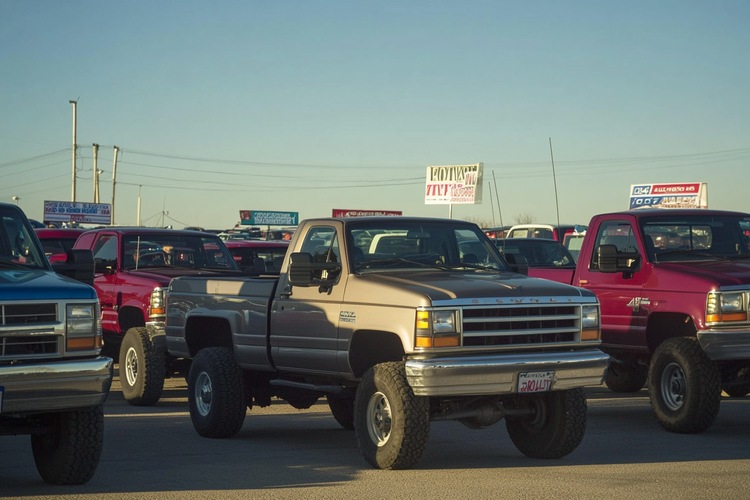Buying a Chevy 3100 Today: Condition Factors, Pricing Ranges, and Common Modifications
The classic Chevrolet 3100 pickup truck represents a significant piece of American automotive history. For collectors and enthusiasts looking to purchase one of these vintage vehicles today, understanding the market requires knowledge about condition assessment, price variations, restoration requirements, and popular modifications. This guide explores what potential buyers should know before investing in this iconic piece of automotive Americana.

The Chevrolet 3100 pickup truck stands as one of America’s most beloved classic vehicles, with its distinctive styling and robust construction making it highly sought after in today’s collector market. Manufactured between 1947 and 1953 as part of Chevrolet’s Advance-Design series, these trucks have transitioned from utilitarian workhorses to prized collector items. For those considering purchasing a Chevy 3100 today, several factors come into play—from evaluating condition and understanding fair market values to knowing common modifications and restoration considerations.
Understanding Chevy 3100 History Before Buying
The Chevy 3100 emerged in the post-World War II era when America’s economy was booming and demand for reliable transportation was high. Introduced in 1947, the Advance-Design series represented Chevrolet’s first major post-war redesign, featuring rounded, more modern styling compared to pre-war models. The 3100 designation specifically referred to the half-ton pickup model, which quickly became popular among farmers, businesses, and everyday Americans. Production continued through 1953, with various updates and improvements throughout its run. Understanding this historical context helps buyers appreciate the vehicle’s significance and identify authentic period-correct features versus later modifications or reproductions. Original features like the five-window cab design, distinctive grille, and dashboard layout vary slightly by production year, making production date verification important for serious collectors.
Evaluating Condition Factors for Chevy 3100 Trucks
When examining a potential Chevy 3100 purchase, condition assessment becomes paramount. Rust represents the primary concern with these vintage trucks, particularly in the cab corners, rocker panels, floor pans, and bed. A thorough inspection should include checking the frame rails for structural integrity, as frame damage can be extremely costly to repair. The condition of original components significantly impacts value—numbers-matching engines and transmissions command premium prices, while period-correct replacements hold less value than original equipment. Interior condition, including the dashboard, gauges, and upholstery, also factors into overall valuation. Buyers should look for signs of previous accidents or poor-quality repairs, such as misaligned body panels or inconsistent paint thickness. Documentation of the truck’s history, including maintenance records and ownership history, can provide valuable insights into how well the vehicle has been maintained over its lifetime.
Chevy 3100 Models and Engine Options
The Chevy 3100 came equipped with several engine options throughout its production run. Most commonly, these trucks featured the 216 cubic inch inline-six engine (known as the “Thriftmaster”), producing approximately 90 horsepower. In later years, some models received the more powerful 235 cubic inch inline-six engine, offering improved performance with around 105 horsepower. Transmission options typically included a three-speed manual, with four-speed manuals available in some configurations. Beyond the standard 3100 half-ton pickup, Chevrolet offered several variants including the 3600 (three-quarter ton) and 3800 (one-ton) models with heavier-duty components. Cab configurations included the standard cab and the deluxe cab, which featured additional trim and comfort features. Understanding these variations helps buyers identify authentic configurations and appropriately value different models based on their rarity and desirability among collectors.
Chevy 3100 Specifications That Impact Value
Several key specifications significantly influence a Chevy 3100’s market value. The truck’s wheelbase typically measured 116 inches for the standard model, with longer versions available for specialized applications. Gross vehicle weight ratings ranged from approximately 4,600 to 5,700 pounds depending on the specific model and year. Original paint colors included various shades of green, blue, red, black, and cream—with original or period-correct paint jobs commanding higher prices than modern colors. Factory options like deluxe cabs, chrome trim packages, heaters, and radios add considerable value when present and functioning. The 1947-1948 models featured a distinctive four-bar grille design, while 1949-1953 models adopted a more modern five-bar grille. Later models (1951-1953) received updated dashboard designs and improved mechanical components. These year-specific details help authenticate vehicles and establish appropriate valuation based on rarity and historical accuracy.
Chevy 3100 Dealers and Pricing Guide
The market for Chevy 3100 trucks varies significantly based on condition, originality, and modifications. Specialized classic car dealerships, auction houses like Barrett-Jackson and Mecum, and online marketplaces such as Hemmings and Bring a Trailer represent the primary sources for these vehicles. Prices range dramatically based on condition and restoration quality.
| Condition Level | Description | Price Range |
|---|---|---|
| Concours/Show Quality | Museum-quality restoration, all original or period-correct parts | $70,000 - $120,000+ |
| Excellent | Professional restoration, minor deviations from original | $45,000 - $70,000 |
| Good | Solid driver, may need minor work, some non-original parts | $25,000 - $45,000 |
| Fair | Running but needs significant work, some rust or damage | $15,000 - $25,000 |
| Project Vehicle | Non-running, extensive restoration needed | $5,000 - $15,000 |
Prices, rates, or cost estimates mentioned in this article are based on the latest available information but may change over time. Independent research is advised before making financial decisions.
Regional factors also influence pricing—trucks in dry, rust-free areas like the southwestern United States typically command premium prices compared to examples from rust-prone regions. Documentation, including build sheets, original sales paperwork, and maintenance records, can significantly enhance value. Buyers should consider budgeting an additional 10-20% beyond purchase price for immediate maintenance needs and upgrades, even for trucks in excellent condition.
How the Chevy 3100 Is Preserved and Modified by Owners
Modern Chevy 3100 ownership typically falls into three categories: preservation, restoration, and modification. Preservation focuses on maintaining the truck in its original condition with minimal changes, addressing only necessary repairs while retaining original components. Restoration aims to return the vehicle to factory specifications, often requiring extensive work to source period-correct parts and materials. Modification, increasingly popular, involves updating the truck for improved performance, comfort, and reliability while maintaining aesthetic appeal. Common modifications include modern engine swaps (often using Chevrolet small-block V8s), disc brake conversions, power steering installations, air conditioning systems, and updated suspension components. Many owners opt for a restomod approach, preserving the classic appearance while incorporating modern mechanical components. Interior upgrades frequently include modern gauges, sound systems, and more comfortable seating. The modification path chosen significantly impacts both the driving experience and the truck’s market value, with purists typically valuing originality while practical-minded buyers often preferring modernized examples.
When purchasing a Chevy 3100 today, buyers should consider their intended use—whether as a show piece, occasional driver, or daily transportation—as this will guide appropriate condition requirements and budget allocation. These iconic trucks continue to appreciate in value, particularly well-preserved original examples and high-quality restorations, making them not just enjoyable classics but potentially sound investments when properly maintained. With proper care and maintenance, a Chevy 3100 can provide decades of enjoyment while preserving an important piece of American automotive heritage.




